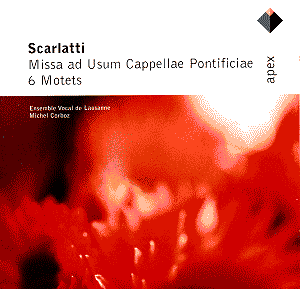There
are some real injustices in the business of recorded music and
this disc brings one of them very much to light. The opening lines
of the liner notes say, "Until relatively recently, the reputation
of Alessandro Scarlatti – the son, brother, father and uncle of
other illustrious musicians – was overshadowed by that of his
son Domenico." It is not stated on this disc whether the
notes were written to go with this Apex re-issue or whether they
date from the same period as the recording, but Alessandro’s reputation,
if he has one, is still very much under his wonderful son’s shadow.
It is an indication of a massive injustice, that this re-issue
goes some small way to correcting.
One
wonders whether readers of this review will be able to name a
single work by Alessandro Scarlatti other than those named above.
Probably not, and yet here we have a composer who wrote no fewer
than 100 Italian operas, some 800 secular cantatas, dozens of
sinfonias, concerti grossi, sonatas, harpsichord and organ works,
vast numbers of oratorios and sacred cantatas, a Passion, 12 Masses
and more than 100 motets. None of it is known because virtually
none of it is published and recordings are thin on the ground,
to say the least. In the case of Alessandro, this is comparable
to knowing of Handel as just a name or as the father of someone
famous. It is almost inconceivably sad that music of the quality
that we know Alessandro produced is now silent, and record companies
are still relying on their back catalogues.
Back
catalogue notwithstanding, this Apex re-issue must be welcomed.
It seemed at first that it was a pity to have to fall back on
a recording made in 1965, but listening shows that there are two
sides to the argument. This writer is usually not in favour of
old recordings of renaissance or baroque music, especially from
the point of view of instrumental technique having changed so
much with the period instrument revival. In the case of the music
recorded here, this becomes less of an issue as it is for unaccompanied
singers, but there are several other reasons. Firstly, the Ensemble
Vocal de Lausanne is a fine group and Michel Corboz, while a product
of his time, had a definite feel for the music that he was directing.
The choir is larger than we would expect nowadays, probably about
25 singers by the sound of it. The quality of the singers is,
however, excellent and although we are dealing with voices used
to singing later repertoire, and with a clear basis in bel
canto technique, this also is a product of its time. It must
be admitted that the sheer sound quality that these singers make
is great, especially the sopranos. While they may be ‘big-chested’
in timbre there is nonetheless a velvety smoothness of line that
is most enjoyable. Corboz takes his tempi more slowly than a modern
performer would, but the sense of line that is so important to
a cappella polyphony is always at the forefront of the
interpretation.
The
second reason why the age of this recording is not such a bad
thing is the curious nature of the music itself. This is strictly
polyphonic, four-part stile antico writing. In other words
Scarlatti has adopted a consciously archaic style in these works.
The Missa ad Usum Cappellae Pontificiae was composed during
one of Alessandro’s sojourns in Rome and was dedicated to the
newly elected Pope Innocent XIII in 1721. It was thus intended
for use not in the Cappella Giulia, the modern instrumental
and vocal ensemble of St Peter’s basilica, but for the Cappella
Sistina, the Pope’s private cappella that sang nothing but
unaccompanied polyphony in the Sistine Chapel. In this mass, the
listener would never know that the composer was one of the great
innovators of the day; the man who established the da capo
aria and developed the three-movement Italian overture. Kyrie,
Gloria and Sanctus are all based on the same motivic material,
and the Agnus Dei makes use of traditions of canonic counterpoint
stemming back to Josquin Dez Pres and earlier. In this context
of the consciously archaic, the performance of 1960’s chamber
choir singers seems no more out-of-place than the music itself
and as each remains beautiful, there is more to enjoy here than
might be apparent at first glance.
The
motets are also in the same archaic unaccompanied style. These
represent something of a rarity in Scarlatti’s oeuvre, for most
of his motets were accompanied, at the least by continuo. More
usually he wrote in the concertante style for soloists, chorus
and orchestra. Only about 20 of these unaccompanied motets were
written. The searching lines of Intellige clamorem meum
or the chromatic harmonies of Ad te Domini levavi add a
sense of baroque piquancy and there are moments of almost operatic
intensity. Corboz beautifully handles all of this, although in
the motets in particular one may wish for a lighter texture at
times.
The
age of the recording notwithstanding this is an enjoyable listen.
It is something of a pity that the works recorded should be so
un-representative of the genius of Alessandro Scarlatti, but in
the present environment, listeners with an interest in this neglected
giant will have to be pleased with what they can find. At the
Apex price there is no reason to avoid this release.
Peter
Wells
